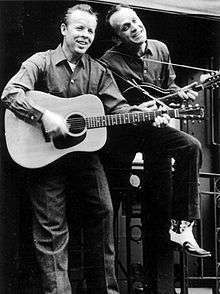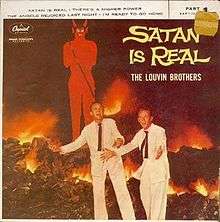The Louvin Brothers
| The Louvin Brothers | |
|---|---|
 Charlie (left) and Ira Louvin | |
| Background information | |
| Origin | Alabama, U.S. |
| Genres | Country, gospel |
| Years active | July 4, 1940 – August 18, 1963 |
| Labels | Capitol |
| Members |
Ira Louvin Charlie Louvin |
The Louvin Brothers were an American musical duo composed of brothers Ira Lonnie Loudermilk (1924–1965) and Charlie Elzer Loudermilk (1927–2011), better known as Ira and Charlie Louvin. The brothers are cousins to John D. Loudermilk, a Nashville Songwriters Hall of Fame member.
The brothers wrote and performed both secular country music, as well as fire and brimstone Gospel music. Ira played virtuoso mandolin and generally sang lead vocal in the tenor range, while Charlie played rhythm guitar and offered supporting vocals in a lower pitch. They helped popularize the vocal technique of close harmony in country and country-rock.[1]
After becoming regulars at the Grand Ole Opry and scoring a string of hit singles in the late 1950s and early '60s, the Louvin Brothers broke up in 1963 due in large part to Lonnie growing tired of Ira's addictions and reckless behavior. Ira died in a traffic accident in 1965. They were inducted into the Country Music Hall of Fame in 2001, and Lonnie died of cancer in 2011.
Background
The brothers adopted the name Louvin Brothers in the 1940s as they began their career in gospel music. Their first foray into secular music was the minor hit "The Get Acquainted Waltz", recorded with Chet Atkins. Other hits included "Cash on the Barrelhead" and "When I Stop Dreaming". They joined the Grand Ole Opry in 1955 and stayed there until breaking up in 1963.[2]
Their songs were heavily influenced by their Baptist faith and warned against sin. Nevertheless, Ira Louvin was notorious for his drinking, womanizing, and volcanic temper.[3] He was married four times; his third wife Faye shot him four times in the chest and twice in the hand after he allegedly tried to strangle her with a telephone cord [4] Although seriously injured, he survived. (Faye is reported to have said, "if the bastard don't die I'll shoot him again!"). When performing and drinking, Ira would sometimes become angry enough on stage to smash his mandolin when he was unable to tune it—and when sober glue it back together. His style was heavily influenced by Bill Monroe, and his brother Charlie, who had a tempestuous relationship with Ira, considered him one of the top mandolin players in Nashville [5]
In his New York Times review of Charlie's biography Satan Is Real, Alex Abramovich said, "Ira Louvin was a full head taller than his younger brother, played the mandolin like Bill Monroe and sang in an impossibly high, tense, quivering tenor. Charlie strummed a guitar, grinned like a vaudevillian and handled the bottom register. But every so often, in the middle of a song, some hidden signal flashed and the brothers switched places — with Ira swooping down from the heights, and Charlie angling upward — and even the most careful listeners would lose track of which man was carrying the lead. This was more than close-harmony singing; each instance was an act of transubstantiation."[6]
In 1963, fed up with Ira's drinking and abusive behavior, Charlie started a solo career,[3] and Ira also went on his own.
Ira died on June 20, 1965, at the age of 41. He and his fourth wife, Anne Young, were on the way home from a performance in Kansas City when they came to a section of construction on Highway 70 outside of Williamsburg, Missouri where traffic had been reduced down to one lane. A drunken driver struck their car head-on, and both Ira and Anne were killed instantaneously.[7] At the time, a warrant for Ira's arrest had been issued on a DUI charge.
Charlie died of pancreatic cancer in January, 2011 at age 83.
Legacy
Country-rock band The Byrds recorded the Louvin-penned "The Christian Life" for their 1968 release Sweetheart of the Rodeo.[2]
In 2001, The Louvin Brothers were inducted into the Country Music Hall of Fame.[8] The tribute CD Livin', Lovin', Losin': Songs of the Louvin Brothers, produced by Carl Jackson and Kathy Louvin and released in 2003, won the 2004 Grammy Award for Best Country Album.
Satan is Real album

Although the brothers are still remembered today for their musical talent, they are also remembered for the unusual cover used for their 1959 album, Satan Is Real. Designed by Ira Louvin, the cover features the brothers standing in a rock quarry in front of a 12-foot-tall (3.7 m) plywood rendition of the Devil as several hidden tires soaked in kerosene burn behind them as fire and brimstone.[9] While some reviewers count this as being one of the "greatest iconic album covers of all time",[10] the cover can also be found today on several Web sites celebrating unusual or bizarre album covers. The cover has also become an Internet meme on a number of Web sites such as Fark.com, where it has been posted in discussion threads as an example of religious views of the era.[11]
The opening bars of the album's title track "Satan Is Real" can be heard at the beginning of Hank Williams III's "Medley: Straight to Hell / Satan Is Real", on his Straight to Hell album of 2006. It is also excerpted in Will Ferrell's 2009 one-man Broadway show, You're Welcome America. A Final Night With George W Bush.
Partial discography
- 1956: The Louvin Brothers (MGM)
- 1956: Tragic Songs of Life (Capitol)[3]
- 1957: Nearer My God to Thee (Capitol)
- 1958: Ira and Charlie (Capitol)
- 1958: The Family Who Prays (Capitol)
- 1958: Country Love Ballads (Capitol)
- 1959: Satan Is Real (Capitol)
- 1960: My Baby's Gone (Capitol)
- 1960: A Tribute to the Delmore Brothers (Capitol)
- 1961: Encore (Capitol)
- 1961: Christmas with the Louvin Brothers (Capitol)
- 1962: The Weapon of Prayer (Capitol)
- 1963: Keep Your Eyes on Jesus (Capitol)
- 1964: The Louvin Brothers Sing and Play Their Current Hits (Capitol)
- 1965: Thank God for My Christian Home (Capitol)
- 1966: Ira and Charles (Hilltop)
- 1967: Two Different Worlds (Capitol)
- 1967: The Great Roy Acuff Songs (Capitol)
- 1968: Country Heart and Soul (Capitol)
- 1973: The Great Gospel Singing of The Louvin Brothers (Capitol)
- 1975: Live at New River Ranch (Collectors Classic)
- 1976: I Don't Believe You Met My Baby (Hilltop)
- 1978: Songs That Tell a Story (Rounder)
- 1990: Early MGM Recordings (Rounder)
- 1992: Close Harmony (Bear Family Records)
- 1995: Greatest Hits (Capitol)
- 1995: When I Stop Dreaming: The Best of the Louvin Brothers (Razor & Tie)
- 2006: The Essential Louvin Brothers 1955–1964: My Baby's Gone (Raven)
Charted singles
| Year | Single | Chart Positions |
|---|---|---|
| US Country[12] | ||
| 1955 | "When I Stop Dreaming" | 8 |
| 1956 | "I Don't Believe You've Met My Baby" | 1 |
| "Hoping That You're Hoping" | 7 | |
| "You're Running Wild" | 7 | |
| "Cash on the Barrelhead"A | 7 | |
| 1957 | "Don't Laugh" | 11 |
| "Plenty of Everything but You" | 14 | |
| 1958 | "My Baby's Gone" | 9 |
| 1959 | "The Knoxville Girl" | 19 |
| 1961 | "I Love You Best of All" | 12 |
| "How's the World Treating You" | 26 | |
| 1962 | "Must You Throw Dirt in My Face" | 21 |
- AB-side to "You're Running Wild".
References
- ↑ Johnson, Jon (October 2003). "Livin' Lovin' Losin' the Louvin's Way". Country Standard Time. Retrieved January 22, 2010.
- 1 2 Wolfe, Charles K. (1996). In Close Harmony: The Story of the Louvin Brothers. Univ. Press of Mississippi. ISBN 0-87805-892-3.
- 1 2 3 Robert Dimery; Michael Lydon (March 23, 2010). 1001 Albums You Must Hear Before You Die: Revised and Updated Edition. Universe. p. 26. ISBN 978-0-7893-2074-2.
- ↑ "'Opry' Singer Star Shot; Wife Jailed". The Miami Herald. February 21, 1963. Retrieved March 27, 2011.
- ↑ Louvin, Charlie (2012). Satan is Real.
- ↑ Abramovich, Alex (February 17, 2012). "'Satan Is Real,' the Story of the Louvin Brothers". The New York Times.
- ↑ Strauss, Neil (November 28, 1996). "The Pop Life". New York Times. Retrieved January 22, 2010.
- ↑ Country Music Hall of Fame entry for The Louvin Brothers. Retrieved January 21, 2010.
- ↑ Stein, Lorin (2006-06-06). "KtB – Satan is Real". Killingthebuddha.com. Retrieved 2012-06-24.
- ↑ "MP3 Blog, Music Blog » The Louvin Brothers :: Satan Is Real". Aquarium Drunkard. 2006-12-13. Retrieved 2012-06-24.
- ↑ "Example of meme-posting of album cover on Fark.com". Fark.com. November 17, 2008. Retrieved November 17, 2008.
- ↑ Whitburn, Joel (2008). Hot Country Songs 1944 to 2008. Record Research, Inc. p. 246. ISBN 0-89820-177-2.
External links
- Official website
- Charlie Louvin interview – July 2010, awaitngtheflood.com
- Country Music Hall of Fame, Nashville – report on Charlie Louvin's 80th birthday, 2007
- State of Mind – A Word with Charlie Louvin – January 2009
- Livin' Lovin' Losin' the Louvin Way. Retrieved January 22, 2010.
- Charlie's life from 1927 to the present on Raised Country!